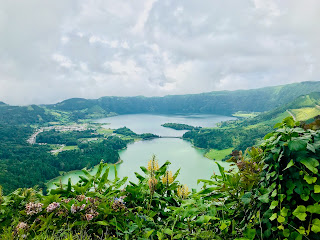São Miguel - an island getaway unlike any other
São Miguel - an island getaway unlike any other
São Miguel is the largest of the nine inhabited islands that constitute the Portuguese autonomous region of the Azores. It is easy to see why it earned the moniker 'Ilha Verde' or green island, with the innumerable shades of green.
This volcanic island situated in the Atlantic Ocean roughly halfway between North America and Europe, has two distinctive geo-physical peaks. Pico da Vara in the East, rising to 1,105m, is the highest point on the island. Pico da Cruz, rising to 850m, is to the West.
The impressive craters of Sete Cidades, Fogo and Furnas are breathtaking mountain lakes with crystal-clear water of striking aquamarine blue and turquoise green colours. Lagao das Sete Cidades in the western part is a must-not-miss if only for it's distinctive Lagao Azul and Lagao Verde (Blue and Green twin lakes) separated by an old road bridge. It is best viewed from either Miradouro da Boca do Inferno (Hell's mouth) or Miradouro da Vista Do Rei (King's view, albeit from a nearby uninspiring decrepit Monte Palace Hotel)
It’s Better to See Something Once Than to Hear About It a Thousand Times ~ Asian proverb.
Furnas
About 45 km drive from the capital Ponta Delgada, is a tourist attraction best known for its geothermal activity around the Calderas da Lagoa das Furnas or Caldeiras Vulcanicas area of Lagao Furnas (Lake Furnas) with pools of boiling mud characterised by malodorous sulphurous fumes and water - but for tourists this has been made safe by use of easily accessible wooden walkways with viewing platforms.
Around 5 a.m. each morning in this misty Azorean village of Furnas, there’s something stewing in the pot - Cuzido nas Caldeiras literally 'cooked in the broiler'. Three-dozen pots with over 90 meals, to be exact, crammed tight with meat (chouriço; chicken; beef brisket; pigs’ ears; ham ends; pork belly; and morcela, a cinnamon-scented blood sausage) and seven types of vegetables (kale, carrots, potatoes, sweet potatoes, cabbage, and taro root) are lowered by moonlight into steaming, hissing pits near the crater lake. These are the ingredients of the fabled slow cooked stew that takes 6 hours using traditional methods. The juices of the ingredients provide the only sauce. The meat is super tender and the veggies are finger licking good.
We decided to have Cuzido for lunch at Parque Terra Nostra or Terra Nostra gardens with has a big selection of trees from all over the world. Don't miss the large geothermal hot pool with iron-rich yellowish water that is kept at a balmy 39C (102F) ideal for the only rainy day we experienced on our trip.
In Furnas, we also visited the remarkable Mata-Jardim Jose do Canto botanical garden on the south shores of Furnas Lake, with a vast collection of outsized trees and a few peacocks arranged as a charming nature walk that starts near the Capela de Nossa Senhora das Vitorias (Our Lady of Victories Chapel). These were commissioned by a wealthy mid-19th century merchant, landowner and intellectual Jose do Canto.
Ponta Delgada
The capital Ponta Delgada is a bustling fishing port with many tourist spots. Make sure to enjoy a walk along the port leading up to Portas da Cidades (the City Gates) with it's characteristic white and black pavement stones laid out in striking mosaic patterns
The capital Ponta Delgada is a bustling fishing port with many tourist spots. Make sure to enjoy a walk along the port leading up to Portas da Cidades (the City Gates) with it's characteristic white and black pavement stones laid out in striking mosaic patterns
Saint Sebastian Church
Saint Sebastian was martyred during the Roman Emperor Diocletian's persecution of Christians in 288 and is the patron saint of Ponta Delgada, the capital of São Miguel. Igreja Matriz de São Sebastião, or simply Matriz, is Ponta Delgada’s main church built between 1531 and 1547 on the site of a small chapel. This Gothic structure also shows Manueline-style traces, typical for the Portuguese architecture in the 16th century, on its exterior as seen on the magnificent portal of its main façade. In the 18th century, the main façade underwent some great changes in the Baroque style of the days.
Tea Plantation
Plantacoes de Cha Gorreana is a family run tea plantation in the Ribeira Grande municipality. Established in 1883, it is one of the oldest, and probably the only, tea plantations in Europe with rows of newly manicured tea bushes - making it a veritable slice of heaven on earth. It came about as a result of Azores diversifying from the competitive orange farming to experiment with tea cultivation and it turned out to be a winner ☕️! Be sure to go on the conducted tour, run on weekdays only, that ends up in the cafe and gift shop to get an idea of how tea leaves are cured and packaged as Black tea (orange pekoe variety) to be savoured by tea connoisseurs everywhere tea is drunk.
Do not go where the path may lead. Go instead where there is no path and leave a trail ~ Ralph Waldo Emerson
Fenais da Luz
We missed the last boat to Ilhéu de Vila Franca (Islet of Vila Franca do Campo) but all was not lost as we were lucky to visit the charming seaside village of Fenais da Luz on the feast day of the Igreja da Nossa Senhora da Luz (Our Lady of the Light Chapel) where we witnessed a short procession with a marching band followed by a mass.
Our memories of Azores will linger on, long after our footprints have faded away




















Comments
Post a Comment
Please keep conversations courteous and on-topic. Kindly don’t engage in trolling, flame-baiting, name-calling, insulting, stereotyping or gratuitous attacks. Thank you for being a good citizen.